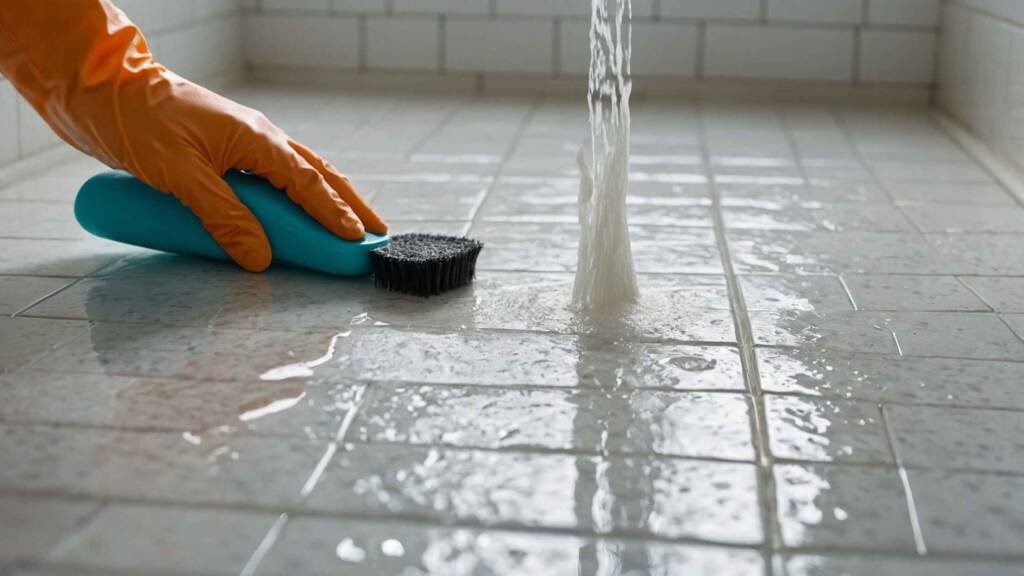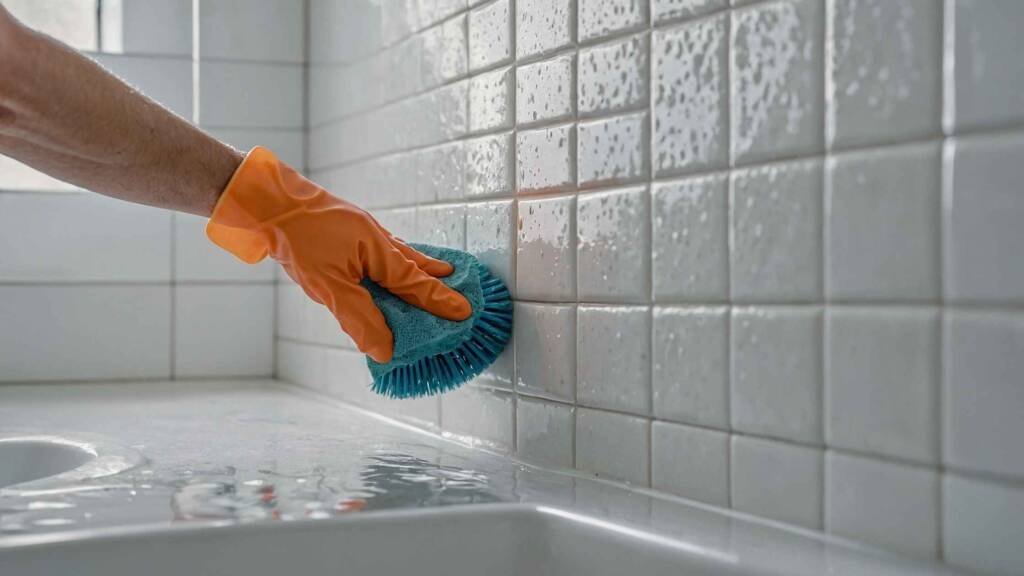Introduction
Not only does mold in the bathroom look bad, it can quickly spread and become a health risk. It’s easy for mold to grow in toilets because they don’t have enough air flow and are always damp and humid. If you don’t get rid of mold, it can damage surfaces, leave smells behind, and even make people with allergies or breathing problems sick.
This guide will lead you through all you need to know about How to Get Rid of Mold in Bathroom. You’ll learn:
- Why bathrooms are so prone to mold
- Safe and effective mold removal methods
- The best products and natural solutions for bathroom mold removal
- Long-term prevention strategies
- When it’s time to call in a professional
If you’re considering a complete bathroom upgrade to eliminate mold for good, check out our bathroom remodel services for expert help.
Table of Contents
Why Bathrooms Are Prone to Mold Growth
Bathrooms are notorious for mold growth, and for good reason. Here’s why:
High Humidity and Frequent Water Use
Every time you take a hot shower or bath, steam fills the air and moisture settles on every surface. Even with regular cleaning, this constant dampness makes it easy for mold spores to take hold and multiply.
Poor Ventilation
Many bathrooms lack adequate ventilation. Without an exhaust fan or open window, humid air lingers, prolonging wetness of surfaces and creating ideal conditions for mold growth.
Common Problem Areas
Mold often starts in the following spots:
- Tile grout: The porous surface of grout absorbs moisture and is difficult to keep dry.
- Ceilings: Especially above showers, where steam collects.
- Shower caulk: Silicone and caulk can trap moisture and develop black mold.
- Exhaust fans: Dust and moisture inside the fan create a hidden mold habitat.
- Under sinks: Leaky pipes and poor airflow make this area a mold magnet.
Health Risks of Mold Exposure
Mold is more than a cosmetic issue. Exposure can lead to:
- Allergic reactions (sneezing, coughing, watery eyes)
- Asthma attacks
- Respiratory infections
- Skin irritation
Particularly sensitive are those with allergies, asthma, or compromised immune systems. That’s why prompt bathroom mold removal is crucial for a healthy home.


Bathroom Mold Removal Safety Tips
Before you tackle mold, it’s vital to protect yourself and your home. Mold spores can be hazardous if inhaled or if they spread to other areas.
Essential Protective Gear
- Gloves: Nitrile or rubber gloves protect your skin from chemicals and mold spores.
- N95 Mask or Respirator: Prevents inhalation of spores and cleaning fumes.
- Goggles: Shields your eyes from splashes.
- Long sleeves and pants: Reduces skin exposure.
Ventilation and Containment
- Ventilate the Area: Open windows and doors, and run the exhaust fan if possible.
- Seal Off the Area: Use plastic sheeting or close doors to prevent spores from spreading to other rooms.
- Dampen Moldy Areas: Lightly mist with water before cleaning to minimize airborne spores.
Chemical Safety
- Never mix cleaning chemicals: For example, bleach and ammonia create toxic fumes.
- Read product labels: Use caution and dispose of items according directions.
Safe Disposal
- Dispose of contaminated materials: Double-bag sponges, rags, or any debris and discard them outside.
- Wash or discard clothing: Launder cleaning clothes separately or dispose of them if heavily contaminated.
By following these bathroom mold removal safety tips, you’ll protect your health and prevent mold from spreading throughout your home.


Best Products and Natural Cleaners to Get Rid of Mold in Bathroom
A variety of products can help you get rid of mold in bathroom environments. Here’s a breakdown of the most effective solutions, both natural and chemical.
Natural Solutions
- White Vinegar: Kills most types of mold on non-porous surfaces. Spray undiluted vinegar, let it sit for an hour, then scrub and rinse.
- Baking Soda: For a paste, mix with water. Scub on tile or moldy grout, let set, then rinse.
- Hydrogen Peroxide: Use a 3% solution in a spray bottle. Spray, let it sit for 10–15 minutes, then scrub and rinse.
- Tea Tree Oil: Mix 1 teaspoon with 1 cup of water in a spray bottle. Spray and leave it-no rinsing required.
- Borax: Dissolve 1 cup in 1 gallon of water. Scrub onto surfaces and leave to prevent regrowth.
Chemical Options
- Bleach: Effective for killing mold on non-porous surfaces. It’s enough to mix one cup of bleach with one gallon of water. Caution: Bleach can discolor grout and damage some surfaces.
- Commercial Mold Removers: Products like Tilex, Kaboom, or RMR-86 Pro are designed for bathroom mold removal and can be highly effective, especially for stubborn stains.
Pros and Cons
| Solution | Pros | Cons |
|---|---|---|
| Vinegar | Natural, non-toxic, cheap | Not always effective on porous areas |
| Baking Soda | Gentle, deodorizes, safe | May require scrubbing |
| Hydrogen Peroxide | Kills mold, disinfects | Can bleach fabrics/surfaces |
| Tea Tree Oil | Natural, pleasant scent | Expensive, strong smell |
| Borax | Prevents regrowth | Toxic if ingested |
| Bleach | Fast, effective | Harsh, can discolor, fumes |
| Commercial Cleaners | Powerful, easy to use | Chemical exposure, cost |
Quick-Reference List: Tools and Materials Needed
- Spray bottles
- Scrubbing brushes (old toothbrush for grout)
- Sponges or non-scratch scour pads
- Microfiber towels
- Protective gear (gloves, mask, goggles)
- Buckets
- Plastic sheeting or garbage bags for debris
How to Get Rid of Mold in Bathroom Tile, Grout, Ceilings, and More
Mold can appear in various areas of your bathroom, and each spot may require a slightly different approach. Below is a step-by-step guide for tackling mold in the most common problem areas.
Tiles & Grout
Step-by-Step:
- Spray the Area: Apply your chosen cleaner (vinegar, hydrogen peroxide, or a commercial mold remover) liberally to the affected tiles and grout.
- Let It Sit: Let the answer do its thing for ten to fifteen minutes. This gives it time to get into the mold and kill it.
- Scrub Thoroughly: Use a stiff-bristled brush or an old toothbrush to scrub the grout lines and tile surfaces. For stubborn stains, reapply the cleaner and scrub again.
- Rinse and Dry: Use a wet microfiber cloth to wipe the area clean, and then dry it completely with a clean towel so that the water doesn’t stay.
Tips:
- Mix baking soda and water to make a paste. Apply the paste to the grout and let it sit for a while. Then, scrub it off after letting it sit.
- Avoid using metal brushes, which can damage grout.
Ceilings
Step-by-Step:
- Prepare the Solution: Use a diluted bleach solution (1 cup bleach to 1 gallon water) or undiluted white vinegar.
- Apply Safely: Dampen a sponge or cloth with the solution and gently wipe the moldy ceiling area. Avoid oversaturating the drywall, as excess moisture can worsen the problem.
- Let It Dry: Do not touch the spot until it is completely dry. If there are spots that won’t go away, repeat the process.
Tips:
- Always wear protective gear when working overhead to avoid drips on your skin or in your eyes.
- If the ceiling is painted, test a small area first to ensure the cleaner won’t damage the finish.
Shower Caulk
When to Clean vs. When to Replace:
- Clean: If the mold is only on the surface, scrub with a bleach solution or hydrogen peroxide. Wait 10 minutes before you scrub with the cleaner.
- Replace: If mold is embedded beneath or behind the caulk, or if the caulk is peeling, it’s best to remove and replace it. Use a utility knife to carefully cut away the old caulk, clean the area thoroughly, let it dry, and apply fresh, mold-resistant caulk.
Exhaust Fans and Vents
Step-by-Step:
- Turn Off Power: Always switch off the fan at the breaker before cleaning.
- Remove the Cover: Gently take off the exhaust fan cover and wash it with warm, soapy water.
- Vacuum Dust: To clean the fan and duct of dust and other things that are stuck in them, use a vacuum with a brush tool.
- Wipe Down: Use a damp cloth and a light cleaning solution to get rid of any mold that you can see on the fan housing.
- Reassemble: Allow all parts to dry before reassembling and turning the power back on.
Toilet and Under-Sink Areas
Safe Cleaning Practices:
- For toilets, use a disinfecting bathroom cleaner or diluted bleach. Scrub under the rim and around the base.
- Under sinks, check for leaks and repair promptly. Clean moldy surfaces with vinegar or hydrogen peroxide, and dry thoroughly.
General Tips:
- Always ventilate the bathroom during and after cleaning.
- Dispose of any heavily contaminated materials (old sponges, rags) in sealed plastic bags.


Long-Term Bathroom Mold Prevention Tips
Getting rid of mold is only half the battle; preventing its return is key to maintaining a healthy bathroom. Here’s how to keep mold at bay for good:
Ventilate
- Use Exhaust Fans: Run the fan during and after showers for at least 20 minutes to remove moisture-laden air.
- Open Windows and Doors: Getting fresh air to the surfaces will help them dry faster.
Dry Surfaces
- Towels & Mats: Hang towels and bath mats to dry after use. Avoid leaving damp fabrics in the bathroom.
- Shower Curtains: Spread out shower curtains and liners to air dry.
Control Moisture
- Fix Leaks: Regularly inspect under sinks, around toilets, and behind the shower for leaks. Repair promptly to prevent water accumulation.
- Dehumidify: If your bathroom tends to stay humid, use a dehumidifier or moisture absorber to keep humidity below 60%.
Clean Regularly
- Monthly Anti-Fungal Cleaning: Once a month, wipe down surfaces with a mold-killing cleaner or a mixture of vinegar and water.
- Check Hidden Areas: Periodically inspect behind and under fixtures for early signs of mold.
Choose Mold-Resistant Materials
- Paints and Caulks: Opt for mold-resistant bathroom paints and silicone caulks during renovations or repairs.
- Upgrades: If your bathroom is prone to chronic mold, consider a remodel with improved ventilation, waterproof materials, and expert installation. For a complete transformation, explore our bathroom remodel services for long-term solutions.
Signs You Need Expert Mold Remediation
While many cases of bathroom mold can be handled with diligent DIY methods, some situations call for the expertise of a professional. Knowing when to seek help is crucial for your health and the integrity of your home.
When to Call a Professional for Bathroom Mold Removal
1. Mold Covers More Than 10 Square Feet
If the affected area is larger than a standard bath towel, it’s time to call in the pros. Large infestations often indicate deeper problems, such as leaks inside walls or extensive water damage, which require specialized tools and containment procedures.
2. Mold Returns After Repeated Cleaning
If you’ve cleaned the same spot multiple times and the mold keeps coming back, there may be an underlying issue such as a hidden leak, poor ventilation, or mold growth inside walls or subflooring. Professionals can find the reason and offer a long-lasting solution.
3. Mold in HVAC, Ducts, or Inside Walls
Mold growth in ventilation ducts, behind drywall, or under flooring is a serious concern. These areas are difficult to access and clean thoroughly without professional equipment. Left untreated, spores can spread throughout your home, affecting air quality and health.
4. Health Symptoms Persist Despite Cleaning
If you or your family experience ongoing allergy or respiratory symptoms even after cleaning visible mold, there may be hidden colonies in your bathroom or elsewhere in the home. Professional remediation ensures that all sources of mold are found and safely removed.
5. Water Damage or Flooding
After a major leak or flood, mold can develop rapidly in hidden areas. Professionals use moisture meters, infrared cameras, and industrial drying equipment to detect and eliminate all traces of mold and moisture.


The Value of Professional Assessment and Remediation
Professional mold remediation companies bring several advantages:
- Thorough Inspection: Experts use advanced tools to locate hidden mold and moisture.
- Safe Removal: They follow strict safety protocols to contain and remove mold without spreading spores.
- Expert Repairs: Professionals can repair or replace damaged materials, such as drywall, insulation, or caulk.
- Prevention Advice: After remediation, you’ll receive guidance on preventing future mold problems, including ventilation upgrades and maintenance tips.
If you’re facing a persistent or large-scale mold issue, don’t risk your health or your home’s value. Professional intervention is the safest, most effective way to restore your bathroom to a clean, healthy state.
Conclusion
Mold in the bathroom is common, but it’s a major problem that needs to be fixed right away. You can keep your family’s bathroom healthy and mold-free by knowing why mold grows, using the right methods for removal, and putting in place long-term prevention plans.
Key Takeaways:
- Act Quickly: As soon as you see mold, you should get rid of it so it doesn’t spread and cause health problems.
- Use Safe, Effective Methods: Choose the right products and protective gear for each job, and never mix chemicals.
- Prevent Recurrence: Ventilate, dry surfaces, fix leaks, and clean regularly to keep mold at bay.
- Know Your Limits: Don’t hesitate to call a professional if you face a large, persistent, or hidden mold problem.
For those considering a more permanent solution, a bathroom renovation can address chronic mold issues by upgrading ventilation, materials, and layout. For expert help, learn more about our bathroom remodel services and discover how we can create a healthier, more beautiful space for your home.
Ready to take control of your bathroom’s health?
Start with these proven steps for mold removal and prevention. For stubborn mold or a complete bathroom transformation, trust our expert team-reach out today and take the first step toward a cleaner, safer, and more inviting home!
If you’d like more tips, guides, or a personalized consultation, don’t hesitate to contact us. Your healthy home starts here!



